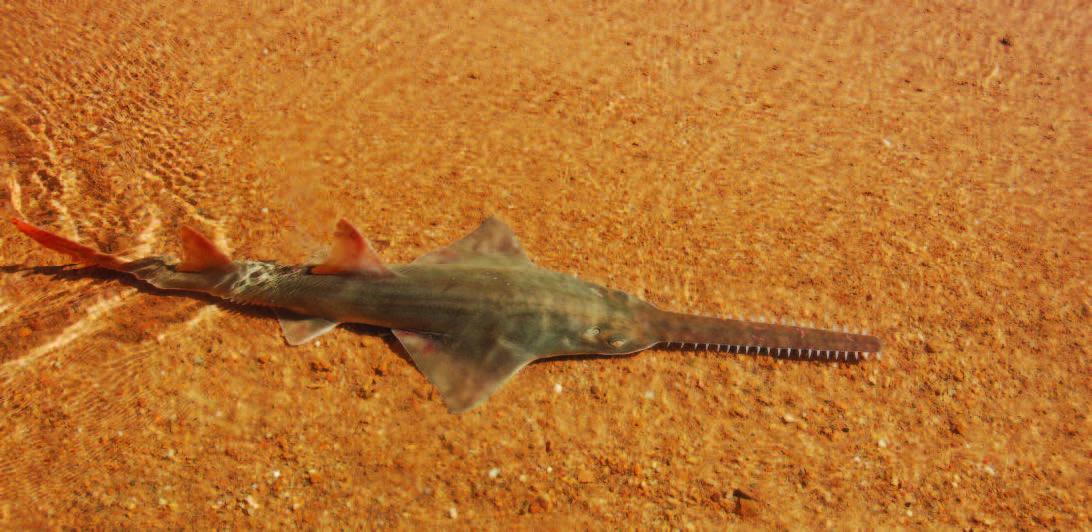
2019 - SAWFISH - DO IT YOUR SELF CONCEPTION
The dark, muddy bottom of King Sound is a fearsome place, swirling with raging tides and shadowed by Bull Sharks and Crocodiles. Sawfish love this dangerous habitat wielding their deadly medieval-looking saw with all the finesse of a Jedi Knight. The rostrum or saw is highly sensitive and can detect tiny vibrations in the water, enhancing its Jedi-like abilities. It is also used to answer one of the oldest questions in the animal kingdom, what is going on in the mind of the opposite sex??
Romance for Sawfish is likely to be a rough and unpleasant affair, particular for females. Firstly, the male tries to get close and cosy with his lady without slicing her eyes out or tearing huge gouges down her flanks. Then he tries to get a good grip on her, which is difficult when you are seven metres long and 40 years old and are being flung around by the raging tide with a less than enthusiastic lady. He usually achieves this by biting her pectoral fin hard, ensuring she can’t get away. Then out comes not one, but two penises or claspers so that he can ensure success no matter what side of the bed he is on. It gets worse. The claspers are rough and barbed so that when he withdraws the female’s bits are grated and torn. This selfishly ensures he is the only father.
Now imagine the pain of trying to give birth to eight baby Sawfish. It’s not as bad as it sounds. Baby Sawfish are kind to their mum as their rostra are softer and coated with a thick goo that protects the mother’s womb during birth. Once the baby Sawfish hit the water the goo falls off, the rostrum hardens up and the real journey begins. Achieving a 500km swim upstream in the wet season floodwaters results in an indulgent four-year holiday in luxurious freshwater pools, where the young grow fast and reach over two metres long. It’s not until they migrate back to the sea that they become mature and complete the life cycle.
Perhaps the brutal nature of heterosexuality for female Sawfish led to a remarkable new ability – parthenogenesis, or do-it-yourself procreation. Recently researchers in Florida have proven that female Sawfish can become pregnant in the complete absence of males, a first for large vertebrates. Was the mother just bored of rough, violent sex and decided to try doing it herself? Or did she decide to do the parthenogenesis thing because there simply were no males around to have sex with.
Globally, Sawfish populations have been devastated, with all five-species listed as endanger or critically endangered. The Fitzroy River and King Sound remain as the most important stronghold for Sawfish and particularly Freshwater Sawfish, left in the world. This is because it is one of the very last big tropical rivers that have not been dammed, overfished, sucked dry or polluted. Even the Ord River used to have healthy populations of Freshwater Sawfish but the construction of the two dams put a swift end to that. Today, the Camballin barrage is the only major obstacle for migrating Freshwater Sawfish. Researchers net juvenile Sawfish every year and carry them above the barrage and release them to ensure some migration upstream still occurs.
If the large cotton irrigators and cattle tycoons ever succeeded in damming the Fitzroy River, they could squarely be blamed for signing the death warrant of one of the most easily recognisable and charismatic species. Should we let it come to that?
FOOT NOTE:
The river is a haven for many species, and remarkably, it is also the world’s last great stronghold for the critically endangered Freshwater Sawfish. Sawfish have been around since the time of the dinosaurs, but now they are at risk of extinction.
The Fitzroy River is the last place on earth where sawfish can be found in true abundance. Each wet season a new generation of baby sawfish head from the ocean to the river. They have been found up to 400 km away from the Kimberley coast!
However, emerging proposals for dams and huge irrigation projects are a major new threat to the river. Dams and irrigation threaten the pools of water that remain after the river stops flowing in the dry season – and where the sawfish and all river life hang on until the rains return. For further information go to:
www.likenowhereelse.org.au also visit
